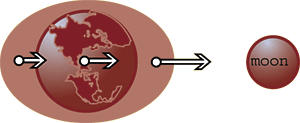|
|
|
|
||||||||||||||||||
Dance
of the Tides p.2
To understand the basic
reason for the tides, stop the moon in its orbit and let it begin
to fall to earth. While we’re stopping things, stop the earth
from spinning, too. The earth’s gravitational pull accelerates
the moon toward the earth. At the same time, the gravitational pull
of the moon accelerates the earth toward the moon. Take a snapshot
of these falling bodies and examine what’s happening on the
earth.
It’s about 13,000
kilometers from one side of the earth to the other—a considerable
distance. Because the gravitational pull of the moon decreases with
distance, a chunk of earth closest to the moon feels a stronger
gravitational attraction by the moon than a chunk at the center
of the earth, and both feel a larger force than a chunk on the far
side of the earth. If it were free of the earth, the chunk nearest
the moon would accelerate faster and be pulled away from the center
of the earth by the greater attractive force, while the chunk on
the far side of the earth would be left behind by the rest of the
earth.
Activities:
|
|
|||||||||||||||||||
|
copyright Exploratorium |
||||||||||||||||||||


